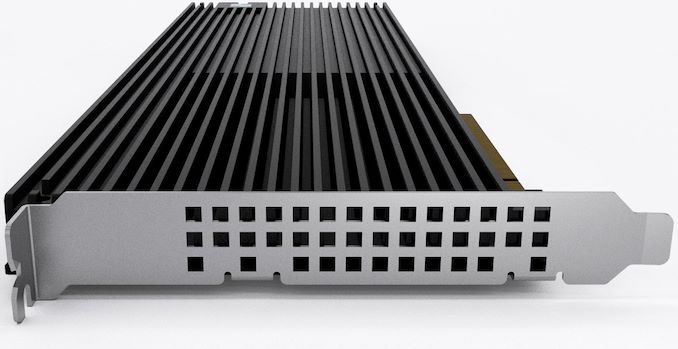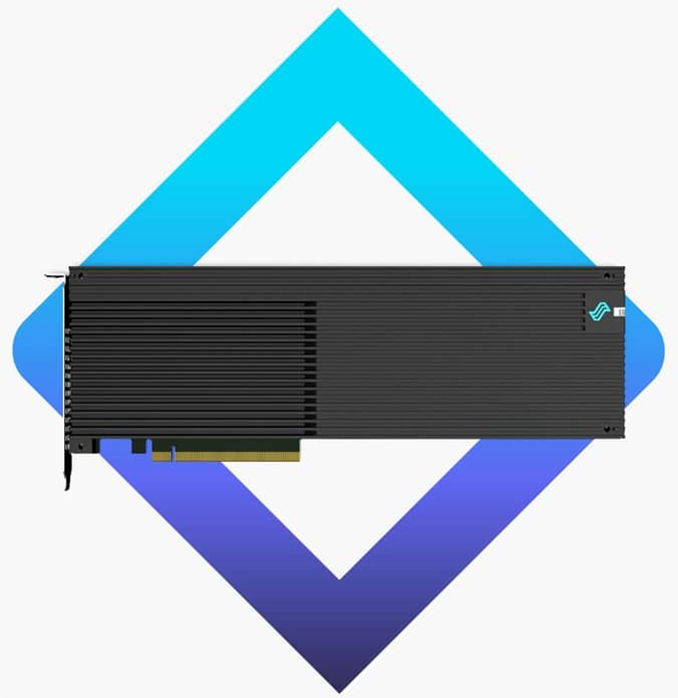Liqid to Demonstrate Element LQD4500 PCIe 4.0 x16 SSD: 32 TB At Up to 24 GB/s
by Anton Shilov on August 2, 2019 11:00 AM EST- Posted in
- SSDs
- Storage
- Phison
- Enterprise SSDs
- PS5016-E16
- Liqid
- FMS 2019

Liqid, a maker of SSDs for mission critical and performance-hungry applications, plans to demonstrate one of the world’s first PCIe 4.0 x16 solid-state drives at Flash Memory Summit next week. The Element LQD4500 SSD is designed to offer superior sequential and random performance along with an enterprise-grade feature set and reliability. Making this all the more noteworthy is that the drive is based on consumer-grade components.
The Liqid Element LQD4500 SSD is based on multiple Phison PS5016-E16 controllers (with a PCIe 4.0 x4 interface) featuring a custom firmware and carries up to 32 TB of raw 3D TLC NAND flash. Liqid is presumably doing on-card NVMe RAID here, similar to what we've seen in some PCIe 3.0 x16 cards in the last couple of years. Being aimed at datacenters or enterprises, the Element LQD4500 supports power loss data protection and features numerous proprietary technologies from Liqid, including active telemetry monitoring, advanced error recovery, and active thermal throttling.
The fastest Liqid Element LQD4500 SSDs will offer up to 24 GB/s sequential read and write speeds as well as up to 4 million read and write IOPS (sustained random writes are rated at 600K IOPS). Such drives will also offer an ~80 μs read access latency as well as a ~20 μs write latency.
The drive comes in a full-height full-length (FHFL) add-in-card (AIC) form-factor with a one-wide passive cooling system, and is therefore compatible with large systems that need extreme performance and can provide a minimum of 400 LFM of air flow, as the card consumes and dissipates up to 65 W of power. Depending on customer requirements, the drive can be configured for different capacities, performance, and endurance levels.
| General Specifications of the Liqid Element LQD4500 SSD | ||
| Data Center Drives | Enterprise Drives | |
| SKUs | 7.68 TB: LQD-E2DPNBD08M007T68 15.36 TB: LQD-E2DPNBD08M015T36 30.72 TB: LQD-E2DPNBD08M030T72 |
6.40 TB: LQD-E2DPNBD08M006T40 12.80 TB: LQD-E2DPNBD08M012T80 25.60 TB: LQD-E2DPNBD08M025T60 |
| Controller | 8x Phison PS5016-E16 | |
| NAND Flash | 3D TLC NAND | |
| Form-Factor, Interface | Full-height full-length (FHFL) add-in-card (AIC) PCIe 4.0 x16, NVMe 1.3 |
|
| Sequential Read | up to 24 GB/s | |
| Sequential Write | up to 24 GB/s | |
| Random Read IOPS | up to 4M IOPS | |
| Random Write IOPS | up to 4M IOPS | |
| Sustained Random Write IOPS | 600K IOPS | |
| Pseudo-SLC Caching | ? | |
| DRAM Buffer | Yes, capacity unknown | |
| AES Data Encryption | Yes | |
| Power Consumption | up to 65 W | |
| Warranty | 3 years | |
| Compatibility | Windows, Windows Server 2012, 2012 R2 RHEL; SLES; CentOS, Solaris, SUSE, VMware | |
| TBW | up to 61.53 PBW | |
| Additional Information | Link | |
| MSRP | ? | ? |
The Liqid Element LQD4500 SSD will be demonstrated at FMS by Phison, which happens to be an investor of Liqid. There is no word regarding availability or pricing of these drives, but given their performance and capabilities, we're not expecting this card to come cheap.
Related Reading:
- Phison’s PS5016-E16 & PS5019-E19: The First PCIe 4.0 Client SSD Controllers
- Memblaze Launches PBlaze5 SSDs: Enterprise 3D TLC, Up to 6 GB/s, 1M IOPS, 11 TB
- Samsung 30.72 TB SSDs: Mass Production of PM1643 Begins
- Intel QLC NAND Updates: Up to 20TB In 2.5-inch SSD
- Unlimited 5 Year Endurance: The 100TB SSD from Nimbus Data
Sources: Liqid, Phison












23 Comments
View All Comments
Dragonstongue - Saturday, August 3, 2019 - link
that would be nifty as oh hell.seeing as NAND operates far better at higher temps (though need to keep everything else away from this level of heat)
You could even put on some small vac tubes(icognito heat exchange to a vapor chamber to help it work better -more so if do a small TEC unit for 50w or so (just enough to keep the controllers happy) and if vac tube, would not be all that hard for an audio card maker to "sister up" with one of their designs, so you get wicked drive performance, a nice "working glow" and crazy nice "on board" sound.
DAMN wish I had the coin I would make it happen .. 1 x16 length card with solid state/nvme not that hard, sound card, not that hard, put vacumm tube on either, really not that hard, marry them without bunch of cables or crap bloatware, that takes skill ( and $$$$$$)
The glow from it working and/or vac tube instead of nasty RGB, I could get me some of that.
olde94 - Sunday, August 4, 2019 - link
i really want to see this happen!Samus - Saturday, August 3, 2019 - link
Needs some LEDs too.5080 - Friday, August 2, 2019 - link
NVMe 1.2.1, interesting. Why did they choose that over NVMe 1.3 or 1.4?prisonerX - Friday, August 2, 2019 - link
Probably because there is a lead time for their own development and testing, and you generally don't want to rely on the latest and most buggy, least supported standard for your new product, if you're a small company at least.5080 - Friday, August 2, 2019 - link
NVMe 1.3 is a ratified standard since 20165080 - Friday, August 2, 2019 - link
It might be a mistake in the data sheet since the Phison PS5016-E16 does support NVMe 1.3ksec - Friday, August 2, 2019 - link
For Reference, last Generation, DDR3 1600 Mhz Memory is 12.8GB/S, this SSD has the speed roughly double or Dual Channel of DDR3.Santoval - Saturday, August 3, 2019 - link
Not quite. DDR3 RAM has more or less the same speed at both sequential and random read and write modes. SSDs and NAND flash work quite differently. They are fastest at sequential read/write and their performance drops fast when switching to random read/write, particularly of very small files.So it's really not such a big deal if SSDs require 6+ TB of NAND, 16 PCIe 4.0 lanes and no less than *four* PCIe 4.0 controllers to match dual channel DDR3 1600 only in sequential read & write speed.
p1esk - Friday, August 2, 2019 - link
3 years warranty? I thought the standard for enterprise is 5 years.